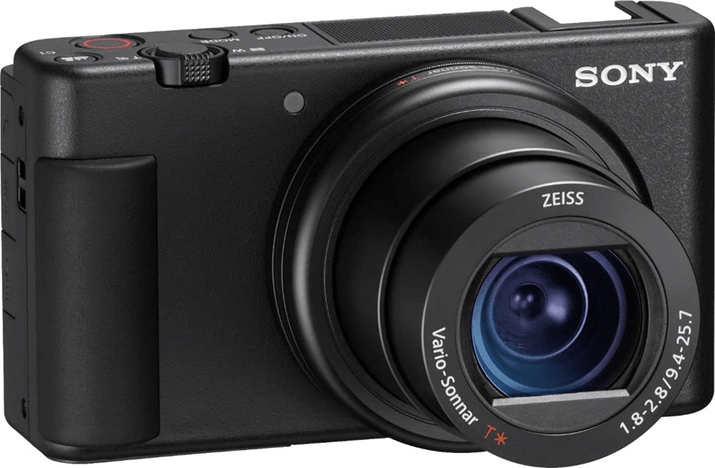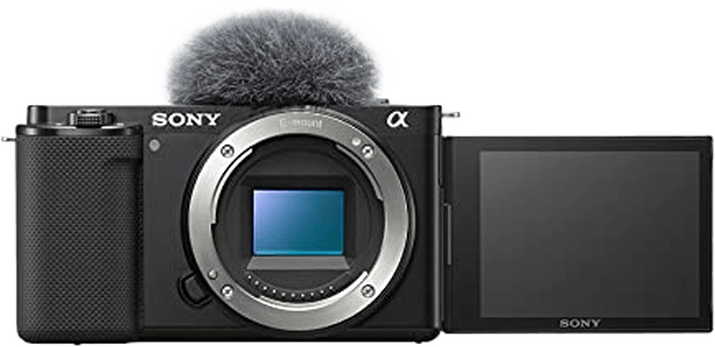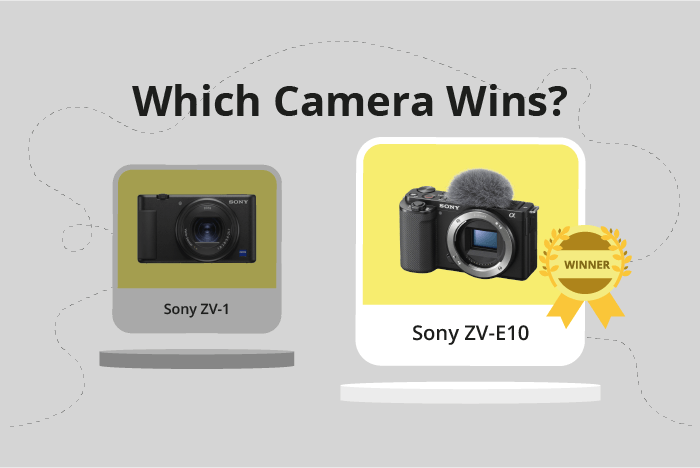Sony ZV-1 vs ZV-E10 Comparison
Sony ZV-1

Sony ZV-E10

The Sony ZV-1 and Sony ZV-E10 both score 65/100, indicating that they are quite similar in terms of general specifications. Both cameras were released in 2020 and 2021, respectively, with the ZV-1 being a compact camera and the ZV-E10 being a mirrorless camera. They share the same launch price range, with the ZV-1 at $800 and the ZV-E10 at $700.
The ZV-1 has the advantage in size and weight, measuring 105 x 60 x 44mm and weighing 294g, making it lighter and more compact than the ZV-E10, which measures 115 x 64 x 45mm and weighs 343g. This difference may appeal to those who prioritize portability and ease of carrying.
On the other hand, the ZV-E10, being a mirrorless camera, offers more flexibility in terms of lens options, making it suitable for photographers who want to experiment with different lenses and styles.
Ultimately, the choice between these two cameras boils down to individual preferences and priorities. The Sony ZV-1 is ideal for those seeking a lightweight, compact camera, while the Sony ZV-E10 offers greater creative freedom with its lens options.
Sony ZV-1 vs ZV-E10 Overview and Optics
The Sony ZV-E10 wins in optics with a score of 69/100, while the Sony ZV-1 scores 67/100. Both cameras share several specifications, such as having a CMOS sensor, Bionz X processor, and similar shooting speeds (24 for the ZV-1 and 11 for the ZV-E10). However, there are noticeable differences that make each camera stand out.
The ZV-E10 has a higher megapixel count at 24, compared to the ZV-1’s 20 megapixels. This results in better image resolution and detail. Additionally, the ZV-E10 has a larger APS-C sensor size and a higher DXOMARK score of 86, which means improved overall image quality and low-light performance. The interchangeable Sony E lens mount on the ZV-E10 also offers flexibility for users to choose from a wide range of lenses, catering to different shooting needs.
On the other hand, the ZV-1 has a few advantages as well. Its shooting speed of 24 is faster than the ZV-E10’s 11, which may be beneficial for capturing fast-moving subjects. Moreover, the ZV-1 features image stabilization, allowing for steadier shots and reduced camera shake, while the ZV-E10 lacks this feature. The ZV-1 also has a 3:2 aspect ratio, which is more suitable for printing photos.
To sum up, the Sony ZV-E10 takes the lead in optics due to its higher megapixel count, better sensor performance, and lens versatility. However, the Sony ZV-1 remains a competitive option with its faster shooting speed, image stabilization, and 3:2 aspect ratio. Users should consider their specific needs and preferences when deciding between these two cameras.
Sony ZV-1 vs ZV-E10 Video Performance
The Sony ZV-1 and the Sony ZV-E10 have identical video scores of 91/100, indicating a tie in terms of video capabilities. Both cameras share several common specifications, such as a maximum video resolution of 4K and a maximum video frame rate of 120fps. Additionally, they both feature built-in time-lapse functionality, which is useful for capturing a series of images over a period and combining them into a video.
Despite the similar scores, the Sony ZV-1 has a slight advantage in terms of video dimensions, with a maximum of 3840 x 2160 compared to the Sony ZV-E10’s 3840 x 1920. This difference in dimensions results in the ZV-1 producing videos with slightly higher resolution and detail. However, the difference is minimal and may not be noticeable to the average user.
On the other hand, the Sony ZV-E10 does not have any clear advantages over the ZV-1 in terms of video capabilities. Both cameras perform similarly in this aspect, making it difficult to determine a winner based solely on video performance.
Given the identical video scores and similar specifications, it is safe to say that both the Sony ZV-1 and the Sony ZV-E10 offer impressive video capabilities. The slight advantage in video dimensions for the ZV-1 may be a deciding factor for some users, but in general, both cameras are well-suited for capturing high-quality videos. Ultimately, potential buyers should consider other factors, such as price, build, and additional features, to determine which camera best meets their needs.
Sony ZV-1 vs ZV-E10 Features and Benefits
The Sony ZV-1 and Sony ZV-E10 both have a feature score of 68/100, indicating that they share many similarities in terms of specifications. Both cameras have a 3-inch screen size, with the ZV-1 having a slightly higher screen resolution at 921,600 dots compared to the ZV-E10’s 920,000 dots. Additionally, both cameras offer touchscreen functionality, flip screens, and lack GPS capabilities. They each have WIFI and Bluetooth connectivity as well.
The Sony ZV-1 stands out with its marginally higher screen resolution, providing a slightly sharper and clearer display for users. This advantage may be beneficial when reviewing images and videos on the camera’s screen.
On the other hand, the Sony ZV-E10 does not possess any distinct advantages over the ZV-1 in terms of features. Both cameras have the same score, and their specifications are nearly identical. While there may be other factors to consider when choosing between these two cameras, their feature sets are essentially equal.
Given the similarities in features and specifications, neither camera emerges as a clear winner. Both the Sony ZV-1 and ZV-E10 offer users a range of useful features, such as touchscreen capabilities, flip screens, and wireless connectivity options. However, the ZV-1’s slightly higher screen resolution may offer a minor advantage for some users. Ultimately, the choice between these two cameras will likely depend on factors outside of their feature sets, such as price, design, and individual user preferences.
Sony ZV-1 vs ZV-E10 Storage and Battery
The Sony ZV-1 outperforms the Sony ZV-E10 in storage and battery with a score of 29/100 compared to the ZV-E10’s 24/100. Both cameras have one memory card slot and accept SD/SDHC/SDXC and Memory Stick Pro Duo cards. The ZV-1 also supports Memory Stick Pro-HG Duo cards, giving it an edge in storage options.
The ZV-1 has a battery life of 260 shots, while the ZV-E10 lasts for 440 shots, making the latter superior in battery life. However, the ZV-1 uses NP-BX1 batteries and offers USB charging, providing users with the convenience of charging on-the-go. The ZV-E10 relies on NP-FW50 batteries and lacks USB charging capabilities.
Despite the ZV-E10’s longer battery life, the ZV-1’s additional storage compatibility and USB charging option make it the winner in this comparison. The ZV-E10’s advantage in battery life may appeal to those who prioritize shooting duration, but the ZV-1 offers a more versatile and convenient experience overall.
Alternatives to the Sony ZV-1 and ZV-E10
Are you still undecided about which camera is right for you? Have a look at these popular comparisons that feature the Sony ZV-1 or the Sony ZV-E10:

